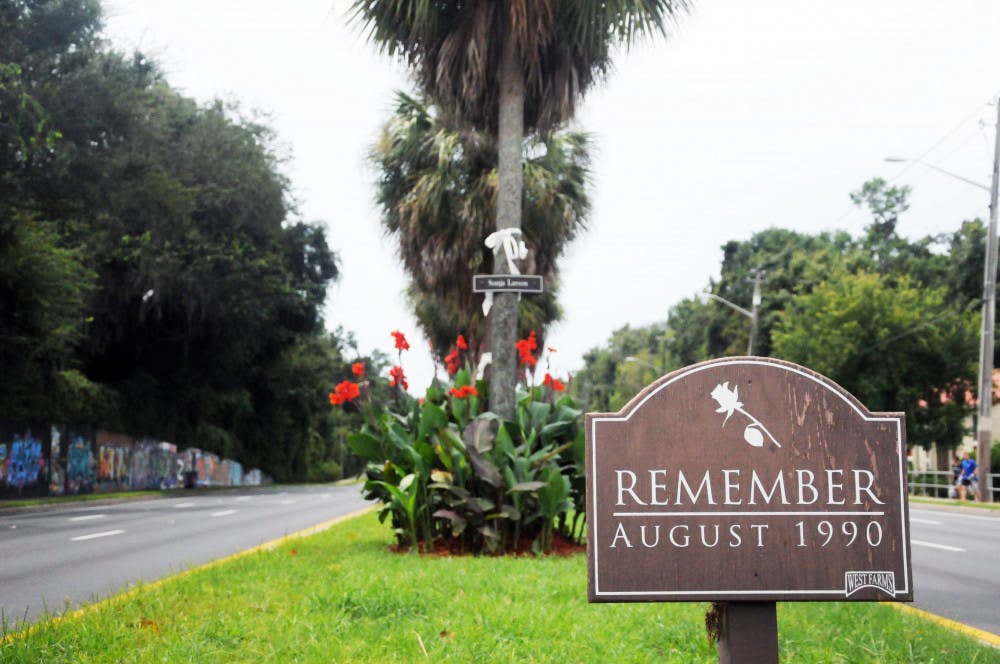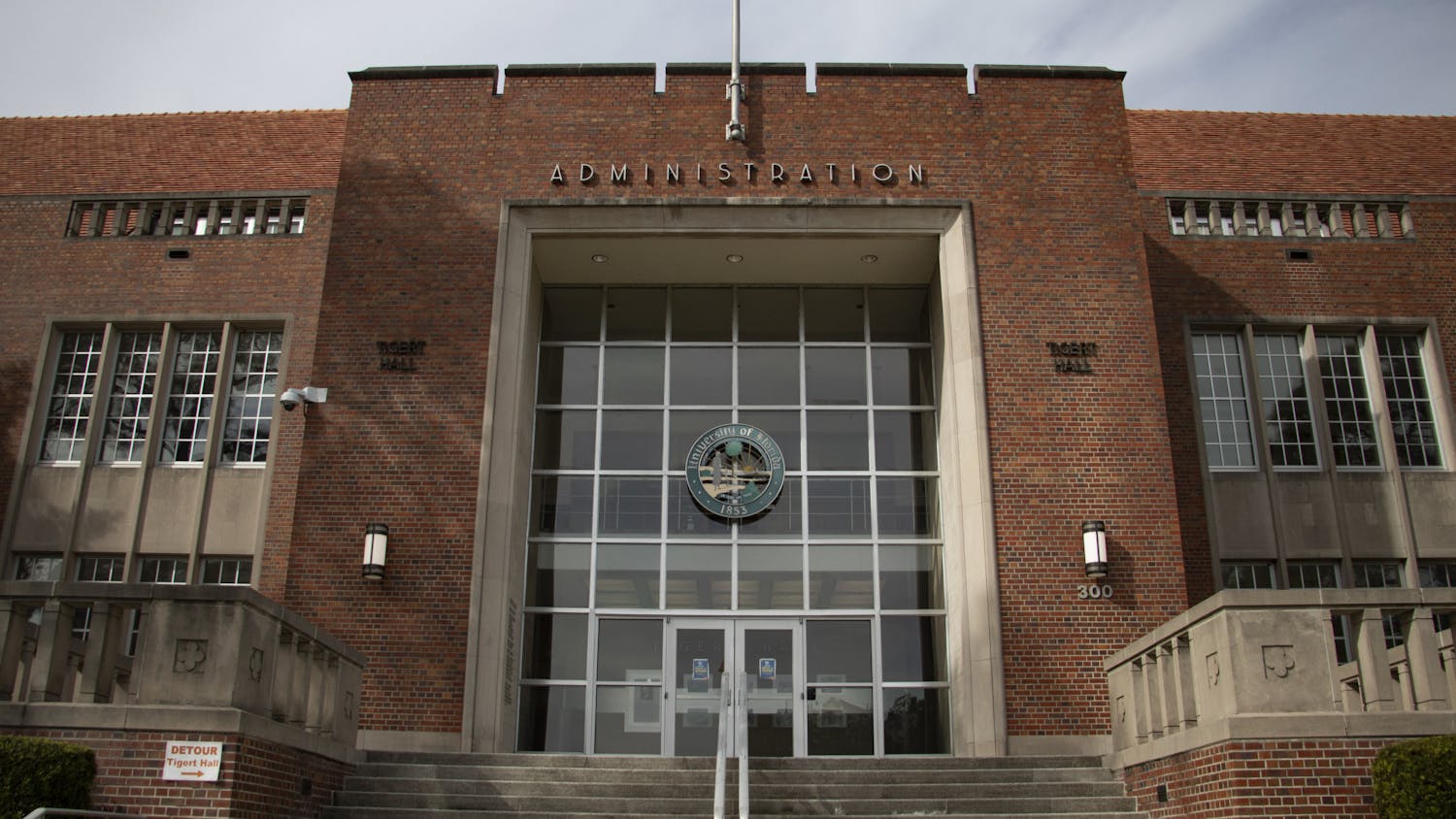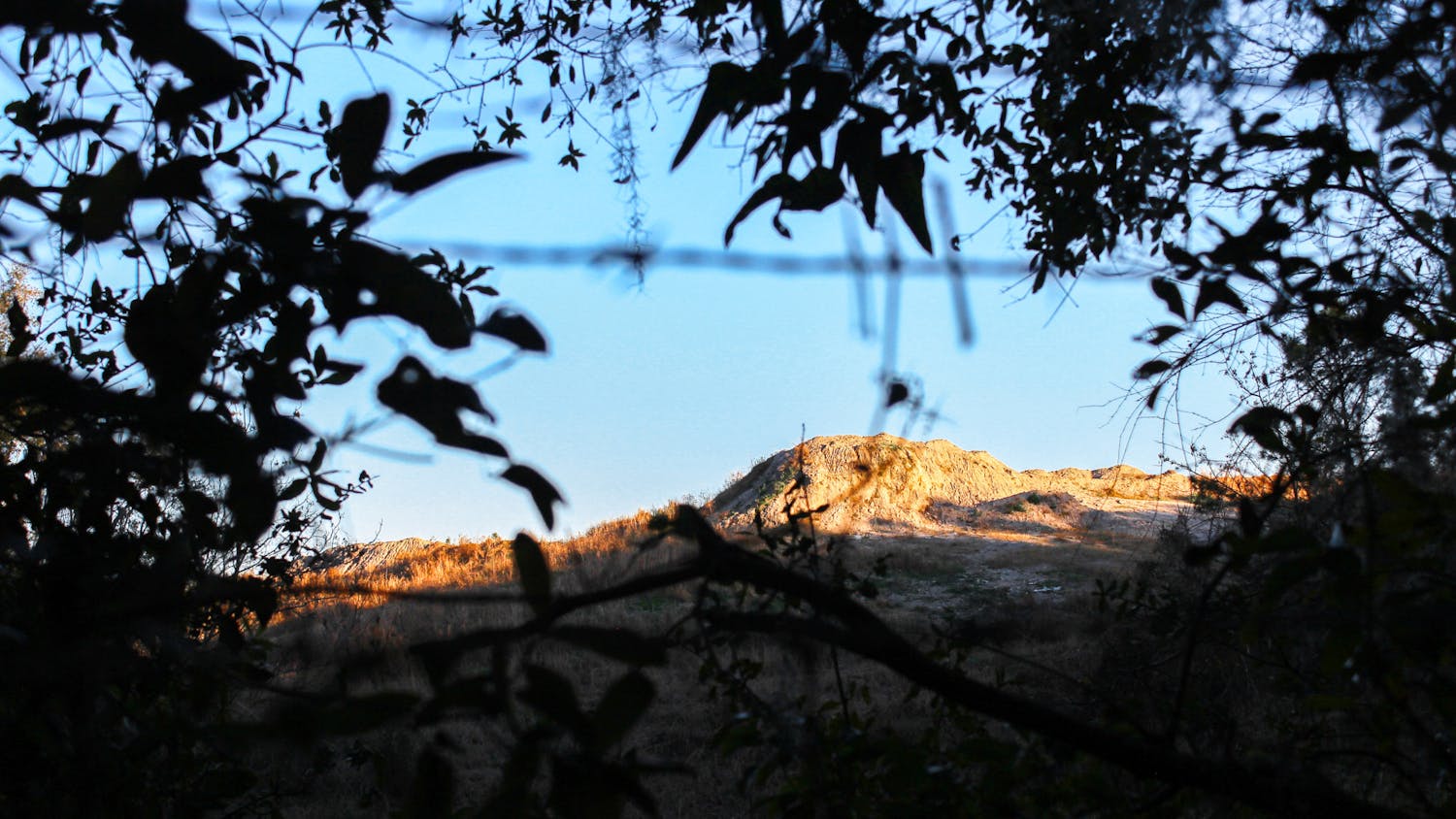In front of the wall, there’s a plaque.
It’s a square of quiet permanence, almost completely hidden under a layer of matted grass.
Weathered bronze on a paint-spattered sidewalk next to Southwest 34th Street, it accompanies a 25-year-old expanse of black paint.
Both carry five names — one etched in bronze and the other painted in white.
Sonja Larson. Christina Powell. Christa Hoyt. Tracy Paules. Manuel Taboada.
The wall commands: Remember.
The plaque promises: You will never be forgotten.
This week reopened a grim chapter of Gainesville’s history from 25 years ago, when five students were murdered in their college town in August 1990 — a chapter unknown to most current UF students.
"A grip of fear"
August 1990 was supposed to be the start of a new era at UF.
About 36,500 students came to campus ready for the start of another year. John V. Lombardi was getting ready for his first semester as the university’s ninth president. Steve Spurrier was preparing for his first season as the Florida Gators head football coach, the start of a dynasty.
But any sense of optimism quickly turned to terror on Aug. 26.
The Sunday before classes were set to begin, the Gainesville community learned that UF freshmen roommates Sonja Larson, 18, and Christina Powell, 17, were found dead and mutilated in their apartment just south of campus.
Within 48 hours, 18-year-old Christa Hoyt, a Santa Fe Community College student, and two more UF students — Tracy Paules and Manuel Taboada, both 23 — were killed as well.
"Each of them was unique, special and brought such promise to our world," Sheriff Sadie Darnell said during a memorial service Tuesday. Darnell was the spokeswoman for Gainesville Police Department in 1990. "They were murdered. There are no words to explain why."
Gainesville had a serial killer on its hands, a man later identified as Danny Harold Rolling. Arrested in Ocala on a burglary charge about two weeks after the murders, he was connected to the murder crime scenes by DNA sampling in November 1991. Rolling pleaded guilty to all five murders on Feb. 15, 1994, and was sentenced to the death penalty on March 24, 1994. He was executed via lethal injection on Oct. 25, 2006.
While the college town tried to comprehend what had occurred, students arriving at UF were now scared for their lives.
Some left town, never to return. Others packed into residence halls and apartment buildings — sometimes as many as 20 people in a room — and took shifts staying up through the night.
"It really felt like a grip of fear," said Spencer Mann, a former lieutenant for the Alachua County Sheriff’s Office and the office’s spokesman in 1990.
Dan McFaul, an 18-year-old freshman in 1990, remembers sleeping in a friend’s home after the attacks. Armed with a baseball bat, he said he slept on the couch with one eye open.
"It was a very deep concern that kind of percolated your whole body," he said. "I don’t think I’ve felt it since."
McFaul, 43, now knows the doorway to his former home in Regency Oaks Apartments faces the woods where Rolling was camped out, knowledge that would have made him reconsider staying in Gainesville.
"Sometimes you just reflect on it," he said. "For folks my generation, this was emblazoned in their memories."
As the case developed, Mann said it was pertinent the community knew that serial killings usually were not immediately solved.
"We almost had to prepare people mentally that we were in this for the long haul," Mann said, "so get ready just as we’re ready."
Lombardi wasted no time making sure UF was ready.
Lombardi wrote in an email that he, along with Student Body President Michael Browne, Vice President for Student Affairs Art Sandeen and other members of administration, ensured they took all security measures possible.
Browne held open meetings for students to voice their concerns.
Students were told they would not be penalized for missing class or going home.
The lounge areas of residence halls became bedrooms for students who lived off campus and were afraid to sleep in their own bed.
And while UF ran business as usual, Lombardi said that looking back, everything was far from ordinary.
"The campus community probably never returned to normal (that semester)," Lombardi said, "as the trauma and shock of the terrible events remained constant in everyone’s mind. … Everyone who was there at the time carries a permanent and painful memory of those days."
But Browne said it was through those tough times that UF became united.
"There was so much uncertainty," Browne said, "but just to see so many people drop everything for safety and the well-being of people was incredible."
In Memoriam
Inside the Baughman Center on Tuesday afternoon, five bouquets of white flowers sat in a semi-circle at the front of the chapel.
The five families, with white ribbons pinned to their chests, embraced each other and the law enforcement who supported them 25 years ago. Together they sat on one side of the chapel, holding hands and tissues as they remembered their loved ones.
"I’m very much humbled to be in the presence of so many of the family members who experienced this tragedy," UF President Kent Fuchs said during the service. "You answered your grief and pain with love and compassion for our students."
But tears began to fall when two parents, Dianna Hoyt and Pat Powell, stood to remember their lost children.
Powell spoke of her daughter Christi and her family’s recovery, thanking members of the Gainesville community for their support.
"The festering has disappeared, and there is a little scar," she said, her hands shaking slightly. "But that scar does not interfere with carrying on with our lives. Our family will never forget, but we are healed and everyone is living a good, normal life.
"All is well."
A place for remembrance
When Adam Byrn Tritt created a mural on the Southwest 34th Street wall remembering the five students, his intention was to give those grieving a temporary sanctuary to mourn.
"We thought it’d last a week or two maybe," Tritt, now 51, said. "Things never last more than a week (on the wall)."
But today, 25 years later, the mural still remains, the lone constant on an ever-changing wall.

Pictured is the mural on the 34th Street wall remembering the five students killed by Danny Rolling. Adam Byrn Tritt, one of the mural’s creators, did not expect it to last longer than a couple weeks.
Once maintained by Darnell and other members of the community, the UF Interfraternity Council has maintained the memorial since 2000, applying fresh coats of paint several times a semester.
"I want to be able to commemorate and respect the families and the students affected by the murders," said Kason Green, 21, who helps paint the wall as IFC president.
The industrial and systems engineering fifth-year said he feels it is important that the IFC maintain the wall so students are aware of the tragic events in 1990.
"I can’t see us stopping," he said. "I have every intention of passing it down to my successors."
When Hoyt stood during the memorial service, she spoke of the wall as a cherished remembrance.
"This is keeping the memory of our children alive, and that means so much for us," she said.
"Everyone can see the shrine, and something of our children lives on through the wall."
Manny Taboada’s brother, Mario, said the wall carries just as much meaning for his mother.
"She shows off the wall like someone shows off their kids," he said after the ceremony.
Living Life
It was hard at first for Taboada to visit Gainesville. But it has gotten easier.
"I don’t think of Gainesville in a negative connotation," he said. "To me, this feels like it’s my brother’s home.
"I’d like to believe they’re perpetual students here."
Besides the wall, there are other tangible memories of the five students throughout Gainesville. Across the street from the wall, five palm trees bear their names and scholarships have been established in their honor.
"Whether people like it or not, it’s part of Gainesville’s historical fabric," Spencer Mann said. "It’s there. It’s not going to go away."
To Mann, the 1990 Alachua County Sheriff’s Office spokesman, current students should know about the 1990 student murders to remind them to exercise basic personal safety.
"None of these victims in these cases did anything wrong," Mann said.
"They were living life the way it is."
While a serial killer coming to town can’t be predicted, it’s not impossible to prepare for.
Jen Day Shaw, UF associate vice president and dean of students, said UF does exercises every semester to prepare for the unknown.
"Whatever it is," she said, "we practice what resources would we need, where there are gaps, how do we communicate."
For Taboada, there’s a different request for students.
"Enjoy life," he said. "Enjoy every minute."
"My brother did."
Contact Emily Cochrane at ecochrane@alligator.org and follow her on Twitter @ESCochrane
Contact Jordan McPherson at jmcpherson@alligator.org and follow him on Twitter @J_McPherson1126
Danny Rolling didn’t have a normal life growing up. It was far from that.
He was born on May 26, 1954, to parents James and Claudia Rolling in Shreveport, Louisiana. James was abusive. According to Alligator archives, James beat Claudia while she was pregnant with Danny and "his brutality pushed her to leave with her newborn child, but she returned not long after in an attempt to save her marriage."
The beatings to both Claudia and her two sons — Danny and Kevin Rolling, who was born one year later — were merciful, according to archives.
Danny found refuge from the abuse in his guitar and alcohol, psychologist Harry Krop said to the Alligator in 2006.
Rolling ran away when he was 17 and joined the Air Force before being discharged for drug problems and stealing a bicycle.
From there, he wandered around the southeast United States, stopping in places such as Georgia, Alabama and Louisiana — committing robberies in each state.
He reportedly killed for the first time on Nov. 4, 1989, when he stabbed William Tom Grissom, 55; Grissom’s daughter, Julie, 24; and grandson, Sean, 8; to death in William Grissom’s home.
Six months later — May 1990 — he tried to shoot his father when they got into a verbal argument.
He traveled to Florida less than three months after that argument, a killer about to take his spree to another level.
-JORDAN MCPHERSON
AUG. 23, 1990: Danny Rolling checked into a Gainesville hotel under the assumed name Michael Kennedy, Jr.
AUG. 26, 1990: The bodies of Christi Powell, 17, and Sonja Larson, 18, both UF freshmen, are found in their two-story apartment, Unit 113, at Williamsburg Villages Apartment.
AUG. 27, 1990: Christa Hoyt, a 18-year-old Santa Fe College student and clerk at the Alachua County Sheriff’s Office, is found dead in her duplex on Southwest 24th Avenue.
AUG. 28, 1990: Tracy Paules, a UF pre-law student, and Manuel Taboada, a UF architecture student, are found dead in their home in Gatorwood Apartments, which was located on the 2300 block of Archer Road.
SEPT. 7, 1990: Danny Rolling is arrested for robbing a Winn-Dixie in Ocala.
NOVEMBER 1991: Rolling is confirmed as the killer through DNA evaluation.
FEB. 15, 1994: Rolling pleads guilty to the five murders.
MARCH 24, 1994: The jury unanimously votes to sentence Rolling to the
death penalty.
OCT. 25, 2006: After 12 years on death row, Danny Rolling was pronounced dead via lethal injection.
Sonja Larson, 18, had just finished her first summer of classes at UF. As a second-semester freshman, she was studying science and pre-engineering.
She managed the girl’s varsity basketball team in high school. According to Alligator archives, her mother, Ada, described her as willowy, popular and quiet.
She said she carried Larson’s Bible with her to church and noted that Psalms 1 through 3 were highlighted.
• • •
Christina "Christi" Powell, 17, had also spent the summer taking classes at UF as a freshman. She was her high school yearbook editor and hoped to pursue architecture. Her mother, Pat Powell, remembered her daughter as a nice and joyful person during a memorial service Tuesday.
"When she was on the phone with one of her friends and I’d be in the kitchen cooking, I could hear her howling with laughter, which also made me laugh," Powell said.
Christi knew her 11 nieces and nephews, spending time with them before she left for college, her mother said. Her youngest nephew, born seven months after her death, was named Christian in her memory.
• • •
Christa Leigh Hoyt, 18, was a student at Santa Fe Community College in August 1990. A records clerk for the Alachua County Sheriff’s Office, she hoped to enter a career in law enforcement.
"Christa was an achiever," said her stepmother, Dianna Hoyt. "She wanted to strive for perfection."
Because of her constant and warm smile, her friends called her "Glowworm," Hoyt said.
• • •
Manuel "Manny" Taboada, 23, had just graduated from Santa Fe Community College and was beginning his junior year as an architecture student at UF. His brother, Mario, said Manny was excited to start school as a Gator.
"He was beside himself to be here," Taboada said. "I think he was going to make a name for himself."
"He had a lot of dreams," he said, remembering his brother as an outgoing and vibrant person.
Taboada had played high school football in addition to serving as Thespians club president and news anchorman at his high school.
• • •
Tracy Paules, 23, was a pre-law student at UF.
At Miami’s American High School, she had played soccer and softball and was elected as Homecoming Queen and class president.
According to Alligator archives, loved ones described Paules as beautiful and poised, greeting her parents with "hi dude" and "hi dudette" on occasion.
Close with her family, her brother Scott got permission for leave from the U.S. Navy in order to escort Paules on the night she was crowned Homecoming Queen.
-EMILY COCHRANE
In 1994, Verlinda McDaniel sat in a courtroom.
As juror No. 2 in the trial deciding if Danny Rolling would receive the death penalty for five murders in 1990, she had to keep a strong face, she said.
"I don’t think I’ve ever felt so angry in my life," she said. "My heart just went out to the family."
She and 11 other jurors eventually recommended the death penalty, a decision she feels was the right one. However, the emotional decision still had a flaw.
"No matter what the decision was," McDaniel said, "we couldn’t bring them back."
The sentence would be fulfilled Oct. 25, 2006.
Drew Harwell was 19 when he reported on Rolling’s execution for the Alligator.
"Danny Rolling in the pictures looked like such an old, frail guy," Harwell, now 28, said. "He didn’t look like the monster who had haunted the city for so long. He just looked like this pathetic old guy."
Outside the prison, Harwell remembers, was a media frenzy.
"There were just really emotional people on both sides," he said, adding that supporters and opponents of the death penalty joined those who remembered the 1990 murders.
Chris Tisch, now an editor at the Tampa Bay Times, described the scene outside the prison as "a bit of a carnival atmosphere" because of all the media. But inside, everything was quiet.
"It’s a peculiar space," Tisch said. "Everyone just kind of sits and watches a person die."
He described it as the oddest execution he has ever witnessed, due to a self-composed country song Rolling sang instead of choosing final words.
"He who flung the stars into heavens above, created the oceans, mountains, eagles and doves," he sang, Tisch said. "None greater than thee, Oh Lord, none greater than thee."
The microphone was cut off after two minutes, and soon what Tisch called "the lethal cocktail" began to flow into his arm.
At 6:13 p.m., the man who terrorized Gainesville was pronounced dead.
For the Alligator writers, their final coverage of Rolling left a lasting impression.
"It sort of pulls you out of that bubble of being young and vulnerable," Harwell, now a writer at the Washington Post, said. "It reminds you how important it is to be appreciating life every day because something like that is so random and cruel."
Dominick Tao, another writer who now serves in the U.S. Army, said he still remembers looking through the pictures of the crime scenes.
"I’ve been to war," he said. "I’ve been to Afghanistan, and nothing I’ve seen could top that tragedy and inhumanity perpetrated by that psychopath."
Years later, he refuses to say Rolling’s name.
-EMILY COCHRANE
A sign that reads "Remember August 1990" stands in the median of Southwest 34th Street. Behind it stands five trees with white ribbons and the names of the five students killed by Danny Rolling. This week marked the 25th anniversary of the murders.
Pictured is a plaque below the mural on the 34th Street wall. The part not covered by debris reads "You will never be forgotten."






